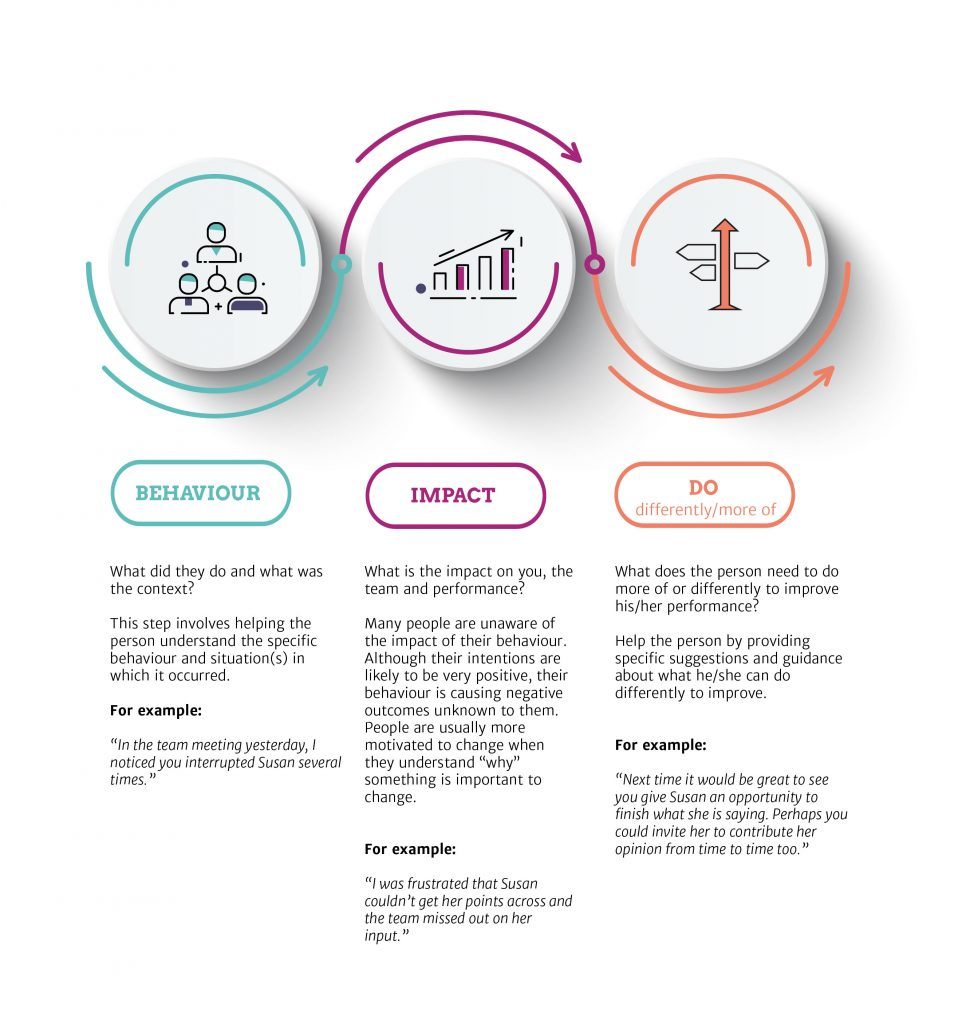Many managers and leaders struggle with tough feedback conversations. They don’t like criticizing people and worry about undermining their relationship and the motivation of the employee if they deliver tough feedback. This often means they end up falling into one of the following traps:
Avoidance – they avoid the conversation in the hope that the problem will miraculously go away or that the person’s poor performance won’t cause any major problems. Of course this rarely happens. The problem typically festers resulting in ongoing performance issues and frustrations among other members of the team.
Watering down tough messages – they apply the popular “sandwich approach” to layer the critical feedback between two layers of positive feedback. The result of this approach is that high performers end up only hearing the negative feedback and become demotivated while poor performers leave the conversation thinking their performance is fine and they don’t need to do anything differently.
Over-criticism – they use an autocratic, overly critical tone. They generalise the critical feedback to the person’s performance overall rather than focusing on the behaviour that needs to be changed. So, they might say something like “you’re always negative in our team meetings” rather than “when Sally was presenting during the last team meeting, I observed that you made a number of critical remarks that you didn’t back up adequately. This left me feeling frustrated as she had done a lot of work to prepare.” This is a particularly risky option, as it is not only leaves people feeling demotivated and angry, but also opens the door for bullying, unfair dismissal claims and resignations.
The benefits of using a strengths-based approach to tough feedback

Despite being incorrectly branded as “too positive” by those who don’t understand the approach, the strengths-based approach offers a powerful new way to help people deal with weaker areas and other performance risks. It does this by:
- Empowering them to have more honest, solutions-focused conversations about how to reduce weaker areas and other risks to performance. It encourages people to think about their natural strengths and whether there is a good fit between these and the work they do. It also encourages them to explore how they can leverage their own and others’ strengths to improve areas where they are weaker. Changing weaker areas is hard work as it usually involves changing stubborn habits we have learned over years or even decades. However, by applying our natural strengths to help unlearn old habits and replace them with new ones greatly improves our chances of success.
- Reducing fears and defensiveness about opening up and acknowledging weaker areas. One of the underpinning principles of the strengths approach is that people are all ‘spiky’, possessing great strengths and also weaknesses. If managers emphasize this at the outset of a coaching or feedback conversation, people will talk more freely about their weaker areas and other blockers to performance.
- Enabling people to reduce strengths that go into ‘overdrive’. Overdrive occurs when people use their strengths too much or in the wrong way, resulting in performance shortfalls and damage to relationships. For example, people who are too confident may become arrogant and those that are too compassionate may become overinvolved in employees’ personal problems. The limiting effects of overdone strengths has been found through research to be a more important source of poor performance than more obvious competency weaknesses. However, in our experience, only around 5% of employees understand their overdrive risks, what triggers these behaviours and how to avoid them.
Six steps to improve the impact of development feedback
Based on decades of experience in helping managers and leaders deal with tough feedback conversations, we recommend applying the following 6 steps:
- Use the BID Feedback Technique™ (see below) – Use a structured feedback process like BIDto ensure your feedback is to the point and covers all the key aspect you need to say to increase the likelihood it will be acted on.
- Focus on the behaviour, not on the person – Ensure you don’t criticize or judge the person; be specific about the behaviour that you would like to see changed and the impact it had.
- Ensure you keep it short – Feedback receivers prefer crisp and clear messages so don’t ramble or provide long explanations. No more than 20-40 words is a good rule of thumb to apply.
- Give the person an opportunity to clarify – Ensure you check that the person understands the feedback. Given them an opportunity to ask clarifying questions.
- Acknowledge the other person’s concerns or emotions – Allow the person to express their point of view and acknowledge any emotions triggered by the feedback.
- Provide suggestions about what they can do differently – Provide specific ideas to help the person change his/her behaviour. To encourage ownership and commitment, check to see whether the person perceives these are useful and explore ways they might adapt these to take account of their own style and strengths.

BID Feedback Technique™
Behaviour
- What did they do and what was the context?
- This step involves helping the person understand the specific behaviour and situation(s) in which it occurred.
For example:
“In the team meeting yesterday, I noticed you interrupted Susan several times.”
Impact
- What is the impact on you, the team and performance?
- Many people are unaware of the impact of their behaviour. Although their intentions are likely to be very positive, their behaviour is causing negative outcomes unknown to them. People are usually more motivated to change when they understand “why” something is important to change.
For example:
“I was frustrated that Susan couldn’t get her points across and the team missed out on her input.”
Do differently
- What does the person need to do more of or differently to improve his/her performance?
- Help the person by providing specific suggestions and guidance about what he/she can do differently to improve.
- Help the person to use their own and co-workers’ strengths to improve their performance (whenever possible).
For example:
“Next time it would be great to see you give Susan an opportunity to finish what she is saying. Perhaps you could invite her to contribute her opinion from time to time too.”
Spot good performance and give positive feedback
Because most human beings are conditioned to focus more on the negatives than on the positives – what psychologists call the “negativity bias”, most managers spend 80% of their time giving critical or negative feedback and only 20% of the time giving positive feedback. It is important for managers to reverse this ratio if they are wanting to build trust and respect with their employees and get the best out of them. Most people, especially high achievers, are energised by praise and recognition so it’s crucial for managers to learn to spot people performing well and giving them feedback to recognise and encourage examples of positive behaviour.
The BID technique can be applied in these situations too with the “D” referring to things they can “Do more of”.
Of course providing constructive feedback doesn’t always work and some employees are unwilling or unable to change. In these cases, it is important for managers to deal with the matter in an upfront, honest and decisive way, ideally with the support of their HR manager or partner. Even in the toughest of situations, the strengths approach provides a powerful ‘lens’ to make sense of what is going on and how to deal with it. For example, some people underperform because their strengths are poorly matched with the requirements of the job and in these cases, it is always better to help them find another position for which they are better suited rather than hoping the situation will resolve itself.
Using a feedback approach that incorporates principles from the strengths-based approach offers a more effective way to tackle one of the biggest challenges we see for managers and leaders. The key is not to avoid these tough conversations or to use a mixed-message ‘sandwich’ approach which is confusing and demotivating. By having honest conversations about the problematic behaviour and using the BID technique outlined above, manages can ensure conversations result in lasting behaviour change, higher levels of motivation and improved results.












